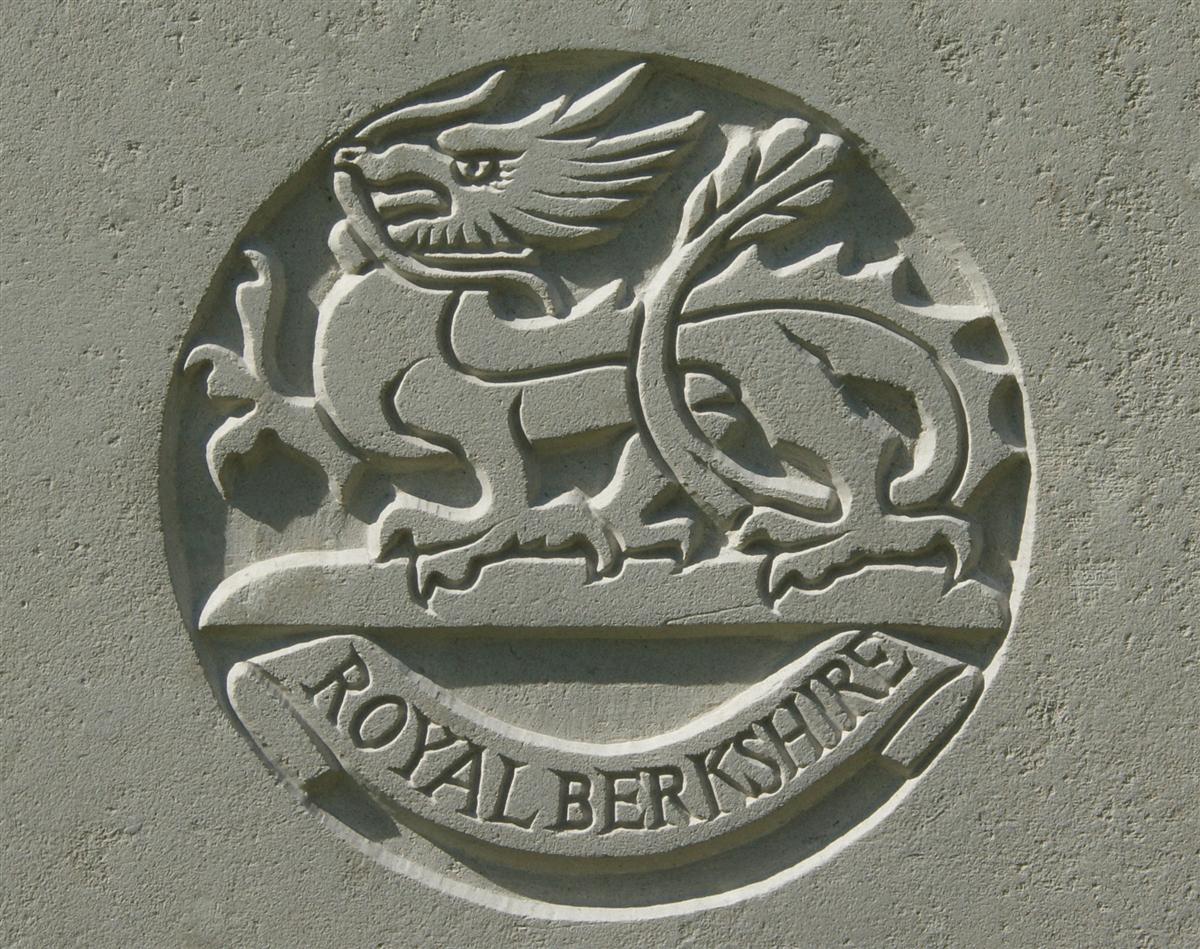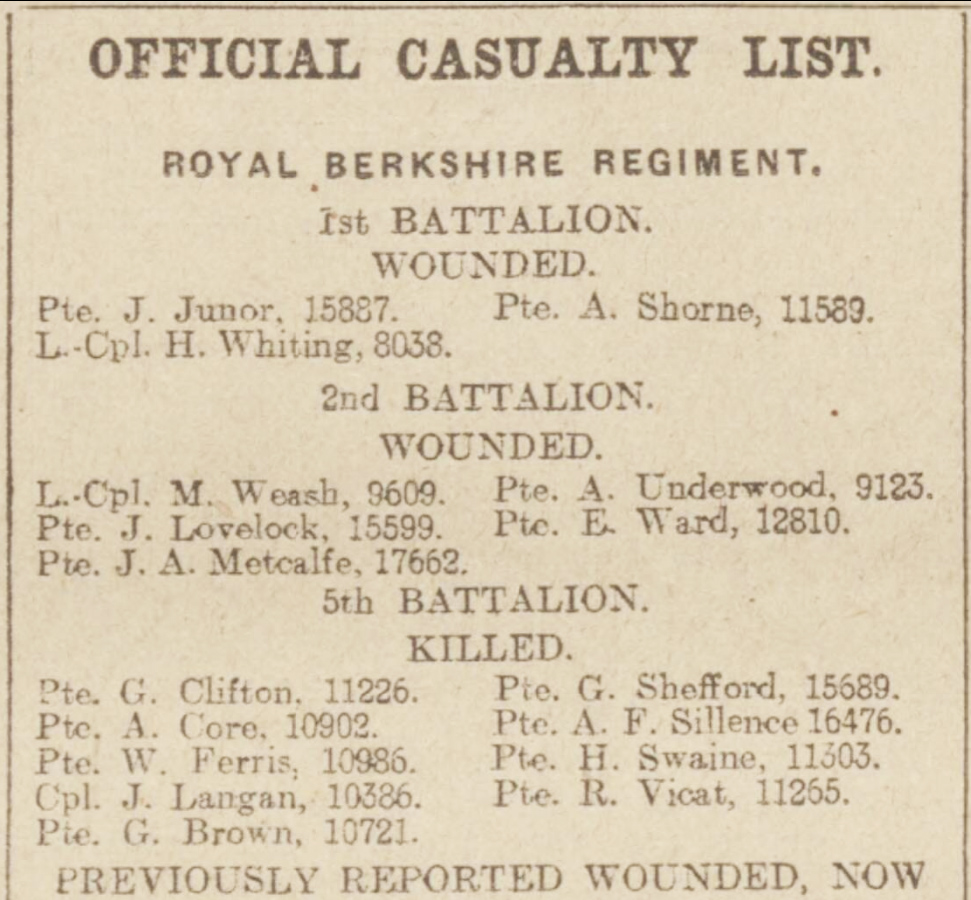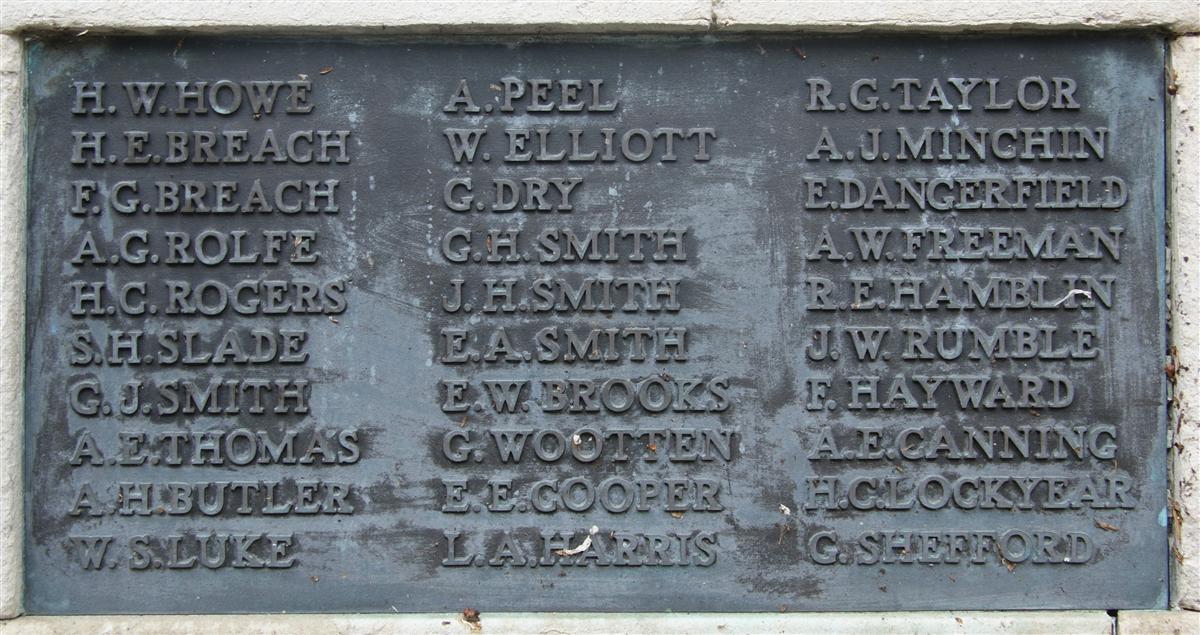George Shefford
Private 15689 George Shefford, 5th (Service) Battalion, Royal Berkshire Regiment
George was born in Crookham in 1895, the son of Edward Shefford and his wife Matilda née Holmes. The couple had eight children, three of whom died in childhood - Ada Rose (1891-1892), Edward William (1892-1892) and Nellie (1896-1896). The five survivors were Ernest (born 1894), George (1895), Mary Elizabeth (1900), Edith Florence (1902) and Albert (1904). Mary Elizabeth would later drop the ‘Mary’ and become Elizabeth Phyllis, and Ernest added Edward by which he was commonly known. The family lived at 2 Jackson’s Cottages, Stroud Green.
Edward senior died in 1913 aged only 49, by which time Edward junior and George were working and could help with the household expenses. Matilda remarried in 1916 to Charles Lovegrove.
After completing his schooling aged 13 or 14, George found employment as a baker’s errand boy. By the time war broke out in August 1914 he would have moved on from errand boy, but no record has been found of his adult employment before he enlisted with the Royal Berkshire Regiment on 25 November 1914.

The regimental badge of the Berkshire Regiment, as used on CWGC headstones. |
Initially the Division was sent to the Ploegsteert area south of Ypres (Ieper) where the new men could be introduced to trench life by experienced men. Before long they were given responsibility for a section of the line in this relatively quiet area.
On 25 September the British launched an offensive north of Arras known as the Battle of Loos. The 5th Berks up at Ploegsteert were involved in some diversionary activities designed to fool the Germans that they were being attacked, but they were convinced they would not be needed for the main event unfolding to the south. Lieutenant Cecil Gold wrote home:
I expect you will have seen from the papers that there is some fighting going on in various places, but all is quiet here so don't let mother get worried. Of course it is possible that they would move us but it is not likely.

Casualty list announcing George's death (Reading Mercury on 20 Nov 1915) |
George escaped the day unscathed and the battle faded out, the last day being officially recognized as 18 October. On that day the Battalion was heavily shelled but casualties were light:
War Diary, 18 October 1915 - 5th Battalion, Royal Berkshire Regiment
Quiet till 5 p.m. when Essex Regt on our left began a bombing attack and captured about 100 yards of trench. Germans shelled us heavily from 5.30 p.m. to 9 p.m. 2 killed 3 wounded and 3 shock.
The following day the battalion was withdrawn from the line:
War Diary, 19 October 1915 - 5th Battalion, Royal Berkshire Regiment
5 a.m. Relieved by 9th Royal fusiliers and marched to billets at VERMELLES. 5 p.m. ordered to "Stand To" and eventually marched at 6.50 p.m. to trenches Old British Front Line. Returned to billets at 11.20 p.m. 2 killed 8 wounded
George’s death is officially recorded as occurring on 19 September, but news reached Newbury that suggested he had died the previous day:
Newbury Weekly News, 28 October 1915 – Killed in Action
SHEFFORD – On Oct 18, 1915, in France, Pte George Shefford, 5th Royal Berkshires, son of Mrs Shefford, of Stroud Green, Newbury, aged 20. Killed in action.

George's name on Newbury War Memorial. (bottom right) |
Whichever day he died, he was probably the victim of enemy shellfire. His body was never identified, and his name is remembered on panel 95 of the Loos Memorial to the missing at the Dud Corner Cemetery just outside Loos-en-Gohelle.
Locally he is remembered on tablet 10 of the Newbury Town Memorial .
George’s elder brother, Edward Ernest Shefford, enlisted with the Royal Berkshire Regiment on 16 December 1914. Fortunately his service record has survived so it is possible to see details of his service, mostly through Army Form B 103 – the ‘Casualty Form – Active Service’. Despite the name this form covers far more than wounds and illness; it also records promotions and disciplinary actions. Most soldiers records have one of these double sided forms, perhaps two if the soldier has been wounded and promoted multiple times - Edward’s record has four!
Unlike George, Edward was trained with the 3rd Battalion, which remained in England throughout the war as a depôt and training battalion. Once he was deemed ready he was sent out to France on 7 April 1915 where he joined up with the 1st Battalion in the field. He evidently impressed his superiors and on 17 May was promoted to Lance-Corporal – quite impressive for a raw recruit joining a Regular battalion. However it was not to last; less than a month later, on 10 June, he was stripped of his stripe ‘for misconduct’. The following month he reported sick, and on 8 July was diagnosed at the 6th Field Ambulance as suffering from gonorrhoea, a complaint that would result in repeated spells in hospital throughout his time in uniform. On this first occasion he was treated an No 9 Stationary Hospital, Havre, from where he was discharged on 15 August and sent to convalesce at No 1 Camp, Havre, where his conduct was once again found wanting and he was sentenced to 10 days’ Field Punishment No 1 for ‘quitting the guard line without permission’ on 19 August. Field Punishment (FP) No 1 consisted of the convicted man being shackled in irons and secured to a fixed object, often a gun wheel or similar. Fortunately for him he could only be secured in this manner for up to 2 hours in 24, and not for more than 3 days in 4.
He was in and out of hospital, with the one spell in a military prison after being sentenced to another 10 days’ FP No 1 for breaking out of camp on 13 February 1916 and being in possession of a fake pass. He was caught within hours, which may have saved him from the far more serious charge of desertion.
It was not until 17 June 1916 that Edward was sent back to his battalion, joining them in the field on 20 June. Only six days after rejoining his battalion he was back in treatment, this time for shell shock and concussion. After a few days rest he was sent back to the battalion on 2 July, the day after the infamous first day of the Battle of the Somme. The 1st Royal Berks were not seriously involved in that battle until 27 July when three companies of the battalion attacked the enemy in Delville Wood, famous now as the site of the South African Memorial. Whilst the attack was a success, losses were considerable – 37 killed, 37 missing and 182 wounded. Edward was among the wounded - once again suffering from shell shock after being buried alive by a shell burst. This time he was given a bit longer to recover before he rejoined his battalion on 10 September.
Once again his qualities as a soldier were recognised by promotion to Lance Corporal (unpaid) on 8 December; on 14 April 1917 the promotion is confirmed and his pay increased accordingly. On 25 April he is again hospitalised with a ‘stricture’ of his urethra, presumably a resurgence of the gonorrhoea. On 15 May he was released from hospital, but not to the 1st Battalion; instead he was posted to the regiment’s 5th Battalion where he was demoted to Private and was soon in trouble again, docked 14 days’ pay for irregular conduct, telling a lie, leaving the trenches on 26 June and not returning until 30 June. Now he was in more serious trouble.
On 6 September he was tried by Field General Court Martial and sentenced to death for ‘When on Active Service deserting His Majesty’s Service’. Six days later, on 12 September Army Command commuted the sentence to ‘5 years penal servitude – sentence suspended’. Edward was extremely fortunate; it can only be surmised that there were significant and extenuating circumstances such as his mental state / shell shock that led Army Command to let him off without even a custodial sentence (although some 90% of death sentences were commuted, most of the reprieved offenders spent time in prison).
He returned to his unit in the field on 20 November, but was wounded in the hand on 22 November. On 25 November he was posted to the 3rd Battalion in Reading at the same time as he was admitted into the 3rd Northern General Hospital in Sheffield. He was allowed Christmas leave before being posted to Ireland where the 3rd Battalion, Royal Berks were stationed for a while at Tipperary and Dublin in the aftermath of the 1916 Easter Rising. In October 1918 Edward was returned to Reading and was attached to 598 Agricultural Company, working on the land. Even then he managed to get into trouble again, this time given 10 days’ detention on 4 November 1918 for striking a ticket collector. While in detention his move to the 598 Agricultural Company was confirmed as a full transfer to the Labour Corps. Another move to 617 Agricultural Company followed in April 1919 before he was discharged to the Reserve on 21 July 1919.
He then applied for a disability pension because issues arising from his hand wound. Although the medical forms survive, they do not include details of any pension granted, or refused.
With a record like his, Edward’s decision in 1922 to apply for enlistment into the Territorial Artillery is a surprise, but apply he did, to join the 99th Brigade (Bucks & Berks Yeomanry) Royal Field Artillery. Perhaps even more surprising is that he is passed fit for service and accepted into the 396th Battery (Berks Yeomanry). However, it seems his records caught up with him and he was discharged ‘in consequence of his service being no longer required’ on 15 December 1922 after only 68 days’ service.
He also found time for romance and married Maud Basset in Newbury on 20 October 1918 setting up home at 13 Trafalgar Place - an alley off the east side of Bartholomew Street. Edward and Maud remained in Newbury for the rest of their lives, Maud dying in 1956 and Edward (who by this date had reverted to using Ernest) on 1 January 1962.

Find a memorial :
| Died this day: | |
| 14 January 1946 | |
| H C Waite | |
| Lower Basildon |

Like this site? Show your appreciation through a donation to a great charity.